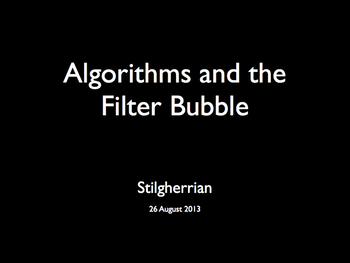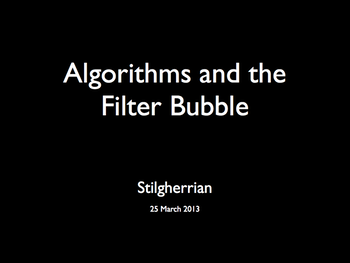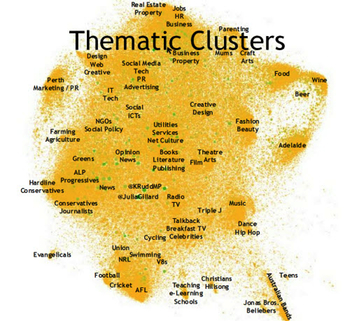 As foreshadowed, on Monday I delivered an updated version of my guest lecture at the University of Technology Sydney, “Algorithms and the Filter Bubble”. And here it is.
As foreshadowed, on Monday I delivered an updated version of my guest lecture at the University of Technology Sydney, “Algorithms and the Filter Bubble”. And here it is.
There’s quite a few changes from the lecture I gave in March, because I wanted to update some key examples.
In fact there’s two versions of the lecture, because I presented it twice — once at 0900 and once at 1300 — and some of the content was improvised around my moderately detailed notes. So I’ll bring you both versions. This is the first, with full audio and the slides.
The repeat of the lecture later in the day was slightly different.
There’s links to all the references over the fold.
As previously, the recording picks up immediately after I was introduced by lecturer, Dr Belinda Middleweek. A transcript may or may not follow at some point in the future.
The audience was primarily first and second year students at the beginning of their media studies degrees. Again, it seems that almost all of this material was brand new to them.
Podcast: Play in new window | Download (Duration: 48:40 — 32.1MB)
[If a transcript ever becomes available, this is where it will appear.]
This work is made available under a Creative Commons BY-NC-SA license. This presentation may be re-used for non-commercial purposes within the terms of the Creative Commons license. The non-commercial and share-alike conditions are required to adhere to the licensing of the imagery used. Please contact me if you require an alternative version. As a minimum, attribution should read: “Source: Stilgherrian.” Online versions must link the word Stilgherrian to the website at stilgherrian.com.
Continue reading “Algorithms and the Filter Bubble, Take 2A”

 Is Facebook on the decline? For some reason or other, I ended up talking about that on the radio on Monday afternoon.
Is Facebook on the decline? For some reason or other, I ended up talking about that on the radio on Monday afternoon. Here’s the guest lecture I delivered at the University of Technology Sydney on 25 March 2012, “Algorithms and the Filter Bubble”. Full audio and slides for now, a transcript to follow in the next few days.
Here’s the guest lecture I delivered at the University of Technology Sydney on 25 March 2012, “Algorithms and the Filter Bubble”. Full audio and slides for now, a transcript to follow in the next few days.